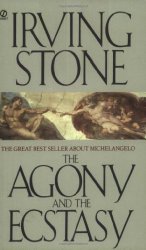I hadn't known about “The Agony And The Ecstasy”, a biographical novel of the great artist Michelangelo Buonarroti by Irving Stone, until Pradnya told me about it. While she had recommended that I read the book before my recent trip to Italy, I ended up reading it only after I had come back from the trip. This book is a majisterial work on the life and the works of a superb sculptor, painter and architect. It deserves to be read by anyone interested in art or history - especially if you have traveled to, or are planning to travel to, Italy.
For a toursit and an art-lover visiting Florence and Rome, this is a particularly nice book to read - whether before, during or after such a trip is debatable. If you have several days or weeks to spare in these cities, then you should try to read this book during your trip. If you read it before your trip, you'll understand a great deal of context behind the art and the architecture you'll encounter in these places, but you'll probably be lost in the numerous art-works, places, streets, etc. mentioned in this book. If you read it after your trip, you'll relate far better to everything mentioned here, but you'll probably badly want to revisit these to admire them with your new-found understanding. I stayed quite close to Casa Buonarroti and the Basilica of Santa Croce when I was in Florence, so it was quite exciting to repeatedly read about these and Via Ghibellina in the book.
This book is truly a labor of love. The author has clearly done an extensive research on his subject over several years, actually been to most of the places he describes and has even taken the time to learn how to sculpt marble. He has done a decent job of putting it together into interesting fiction. This is a big book at close to 700 pages, but the author manages to mostly retain the interest of the reader. You get to know about the life and times of Michelangelo and how it was in medieval Italy. It is really amazing how he managed to produce his great works, while being bogged down by papal vagaries and a perpetually nagging family. It is also interesting to see other great artists like Leonardo da Vinci, Raphael Sanzio and Sandro Botticelli appearing in the life of Michelangelo, though sadly not always as positive forces. You also get to read about the Medicis, Savonarola, Machiavelli and a surprising number of Popes.
Some parts of the book are a little tedious though. There are many pages devoted to detailed descriptions of his surreptitious dissections of corpses. I must admit that I didn't find many of the translated sonnets of Michelangelo that appear in this book that interesting (yes, he was a prolific poet too). I especially hated the several “walk-through” type of passages in the book that some tourists might like, but that are awkward in a novel. For example:
“[Michelangelo] walked down the Via dell'Anguillara, the streets freshly washed and the stoops scrubbed, to Piazza Santa Croce, where the Franciscan church stood rough and dark in its unfinished brick. As he passed the open-sided gallery his eyes sought the outline of the Nino Pisano sarcophagus, held up by its four carved allegorical figures. He turned left on the Via del Fosso, build at the second limit of the city walls, passed the prison, then the house belonging to the nephew of St. Catherine of Sienna, and at the end of the street, at the corner of the Swallows, the city's famous chemist shop. From here he turned into Via Pietrapiana, Street of the Fiat Stones, which led through Piazza Sant'Ambrogio, in the church of which were buried the sculptors Verrocchio and Mino da Fiesole.”
...and so on.
There are several interesting parallels between the way the author describes Michelangelo's passion for sculpture and the way passionate programmers approach software-development. He used to regularly “get in the zone” while sculpting marble, some times for years; so much so that food, sleep, friends, etc. used to become irritating distractions. He was always itching to sculpt marble, being miserable when he couldn't. He could not bring himself to do a bad job even on something that he did not agree with. He was such a perfectionist that he could not delegate much work to his assitants, even if that meant taking much more time than was expected. He was more of an “individual contributor” than a “team player”. He was “hands-on” till the very end of his life (yes, even after he had become an architect...of St Peter's Basilica).
This great artist produced an astounding amount of work, many of them classics truly appreciated only when seen in person. It is really sad to see how much trouble he had to go through to create them. Read this book to better appreciate his life and his work, as well as the creative process itself.
